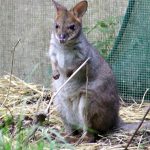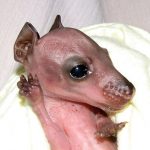RED-LEGGED PADEMELON
The Red-Legged Pademelon can be found in rainforests adjacent to wet sclerophyll forests with dense undergrowth and grassy areas. They inhabit regions in New South Wales, Queensland, and New Guinea.
Their fur is incredibly soft, with a gray-brown color on the upper body and a cream color on the underside. The cheeks, forehead, forearms, hips, and hind legs are russet brown. The nose often has pink and black speckles. Compared to the Red-Necked Pademelon, the Red-Legged Pademelon has a pointed face and a short, stumpy tail measuring around 30-44 cm, covered in fine and sparse fur.
In terms of weight, males range from 3-9 kg, with some reaching up to 7 kg. They continue to grow throughout their lives and are generally larger and more muscular in the forelimbs and chest compared to females, who weigh around 2-4.2 kg. Both sexes reach sexual maturity at 11-18 months.
Red-Legged Pademelons are shy and solitary animals, but they may gather in groups to feed on grasses, ferns, herbs, fungi, shrubs, soft plants, leaves, fruits, and even insects found on the forest floor.
They are active from late afternoon through the night and return to their shelters by dawn. When resting, they position their tail between their outstretched hind legs while leaning against a rock or small tree. Their head rests on their tail between their outstretched legs as they sleep .
Typically, they do not venture far from the forest edge, generally staying within a range of 30-100 meters.
Breeding among Red-Legged Pademelons in the northern regions is continuous, with birth peaks occurring in the autumn and spring.
When alarmed, Pademelons thump their back foot as a warning signal to others of potential danger.
The major threats to these creatures include habitat loss due to clearing, as well as predation by dogs, cats, foxes, large birds of prey, pythons, and collisions with motor vehicles.
The Red-Legged Pademelon is considered a vulnerable species in NSW primarily due to the loss of its habitat and predation by introduced foxes, as well as wild and domestic roaming dogs.




























